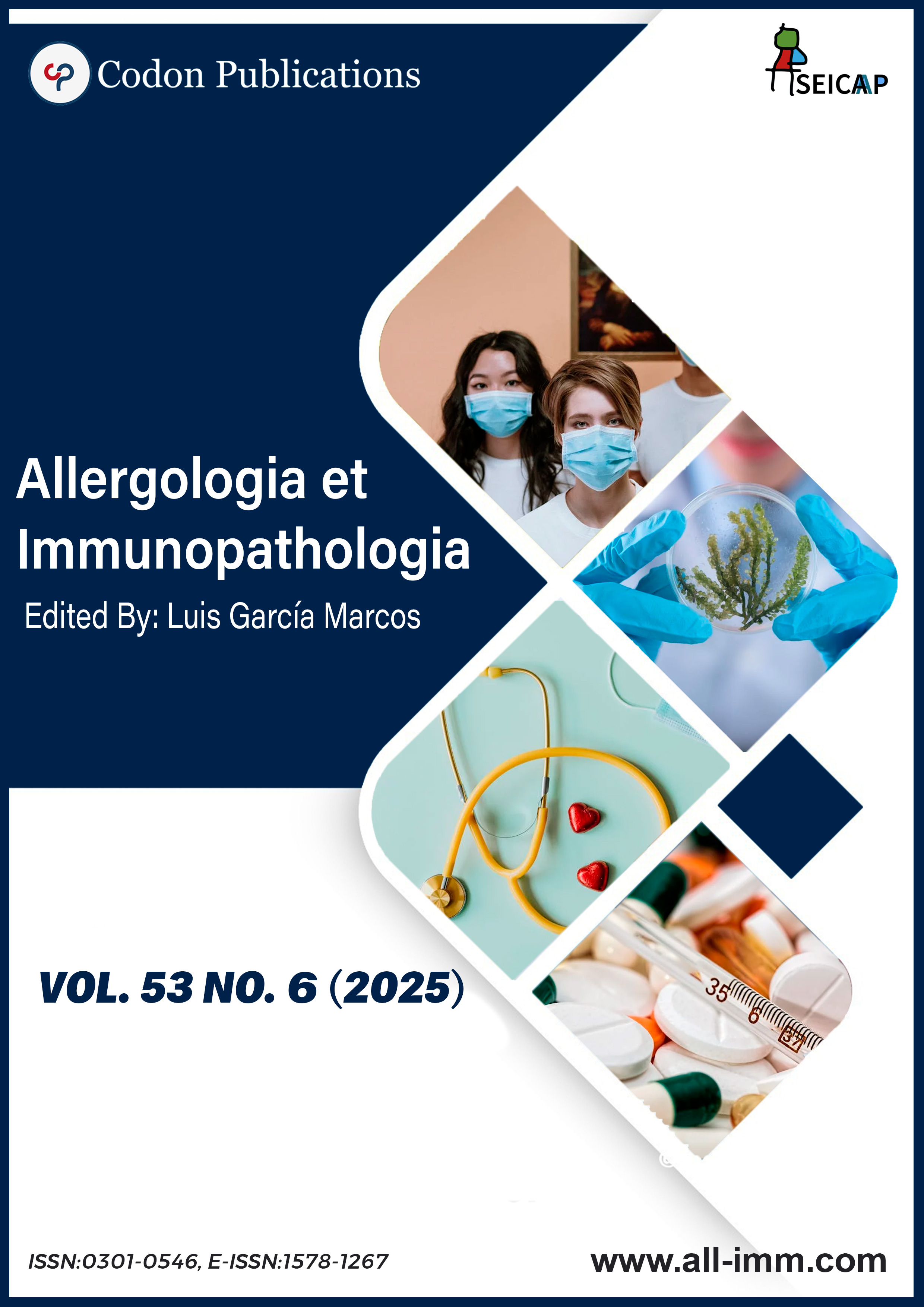Alteration of triggers and symptoms by age group in childhood and adolescence anaphylaxis
Main Article Content
Keywords
allergens, anaphylaxis, children, etiology, diagnosis
Abstract
Background: Anaphylaxis is a severe, potentially fatal, systemic hypersensitivity reaction induced by various triggers.
Objective: Only a few studies have examined the clinical manifestations of childhood anaphylaxis across different age groups. We aimed to evaluate, according to age group and trigger, the clinical features of anaphylaxis in pediatric patients.
Methods: We retrospectively evaluated 130 children diagnosed with anaphylaxis over 11 years.
Results: The median age of the patients was 10 years (min–max: 0.5–17.8), and 83 (63.8%) were male. Regarding age groups, 23 (17.7%) of the patients were infants, 26 (20%) were preschoolers, 31 (23.8%) were school-age children, and 50 (38.5%) were adolescents. Among the causes with known triggers, the most prevalent trigger was identified as food— affecting 44 (33.8%) cases—followed by drugs (34 cases, 26.2%) and venoms (18 cases, 13.8%). There was a statistically significant relationship between age groups and triggers (p < 0.001). The triggering role of drugs and venoms was found to be low in infants. Also, the infant group had significantly lower risks of venom-induced and drug-induced anaphylaxis compared to the adolescent group. The top three triggers identified in our patients were compared according to the system involved, and a statistically significant relationship was found between triggers and cardiovascular findings (p = 0.006).
Conclusion: The etiology of anaphylaxis may vary by age group. Depending on the trigger, it may also have different clinical manifestations.
References
2 Tarczoń I, Jedynak-Wąsowicz U, Lis G, Tomasik T, Brzyski P, Cichocka-Jarosz E. Is the clinical manifestation of anaphylaxis in children influenced by the trigger of reaction? Postepy Dermatol. Alergol. 2021;38(5):788–797. 10.5114/ada.2020.95650
3 Muraro A, Worm M, Alviani C, Cardona V, DunnGalvin A, Garvey LH, et al. EAACI guidelines: anaphylaxis (2021 update). Allergy. 2022;77(2):357–377. 10.1111/all.15032
4 Navalpakam A, Thanaputkaiporn N, Poowuttikul P. Management of anaphylaxis. Immunol. Allergy Clin. North Am. 2022;42(1):65–76. 10.1016/j.iac.2021.09.005
5 Golden DBK, Wang J, Waserman S, Akin C, Campbell RL, Ellis AK, et al. Anaphylaxis: a 2023 practice parameter update. Ann. Allergy Asthma Immunol. 2024;132(2):124–176. 10.1016/j.anai.2023.09.015
6 Comberiati P, Spahn J, Peroni DG. Anaphylaxis in adolescents. Curr. Opin. Allergy Clin. Immunol. 2019;19(5):425–431. 10.1097/ACI.0000000000000572
7 Anagnostou K. Anaphylaxis in children: epidemiology, risk factors and management. Curr. Pediatr. Rev. 2018;14(3):180–186. 10.2174/1573396314666180507115115
8 Muraro A, Roberts G, Clark A, Eigenmann PA, Halken S, Lack G, et al. The management of anaphylaxis in childhood: position paper of the European Academy of Allergology and Clinical Immunology. Allergy. 2007;62(8):857–871. 10.1111/j.1398-9995.2007.01421.x
9 Turgay Yagmur I, Kulhas Celik I, Yilmaz Topal O, Civelek E, Toyran M, Karaatmaca B, et al. The etiology, clinical features, and severity of anaphylaxis in childhood by age groups. Int. Arch. Allergy Immunol. 2022;183(6):600–610. 10.1159/000521063
10 De Filippo M, Votto M, Albini M, Castagnoli R, De Amici M, Marseglia A, et al. Pediatric anaphylaxis: a 20-year retrospective analysis. J. Clin. Med. 2022;11(18):5285. 10.3390/jcm11185285
11 Salvati L, Vitiello G, Parronchi P. Gender differences in anaphylaxis. Curr. Opin. Allergy Clin. Immunol. 2019 Oct 19(5):417–424. 10.1097/ACI.0000000000000568
12 Lee SY, Ahn K, Kim J, Jang GC, Min TK, Yang HJ, et al. A multicenter retrospective case study of anaphylaxis triggers by age in Korean children. Allergy Asthma Immunol. Res. 2016;8(6):535–540. 10.4168/aair.2016.8.6.535
13 Leung ASY, Tham EH, Pacharn P, Xing Y, Trinh HKT, Lee S, et al. Disparities in pediatric anaphylaxis triggers and management across Asia. Allergy. 2024;79(5):1317–1328. 10.1111/all.16098
14 Worm M, Moneret-Vautrin A, Scherer K, Lang R, Fernandez-Rivas M, Cardona V, et al. First European data from the network of severe allergic reactions (NORA). Allergy. 2014;69(10):1397–1404. 10.1111/all.12475
15 Serbes M, Sasihuseyinoglu AS, Ozcan D, Ufuk Altıntas D. Clinical features of anaphylaxis in children. Allergy Asthma Proc. 2022;43(1):50–56. 10.2500/aap.2022.43.210089
16 Uthaisangsook S, Hirunwattana N, Kajornrojanaruk C, Padsee N. Characteristics of anaphylaxis from a tertiary-care hospital in lower northern Thailand: a ten-year retrospective cross-sectional study. Asian Pac. J. Allergy Immunol. 2024. doi:10.12932/AP-010424-1831
17 Muraro A, Roberts G, Worm M, Bilò MB, Brockow K, Fernández Rivas M, et al. Anaphylaxis: guidelines from the European Academy of Allergy and Clinical Immunology. Allergy. 2014;69(8):1026–1045. 10.1111/all.12437
18 Cetinkaya PG, Buyuktiryaki B, Soyer O, Sahiner UM, Sekerel BE. Factors predicting anaphylaxis in children with tree nut allergies. Allergy Asthma Proc. 2019;40(3):180–186. 10.2500/aap.2019.40.4211
19 Nunes FA, Zanini F, Braga CS, da Silva AL, Fernandes FR, Solé D, et al. Incidence, triggering factors, symptoms, and treatment of anaphylaxis in a pediatric hospital. World Allergy Organ. J. 2022;15(9):100689. 10.1016/j.waojou.2022.100689
20 Sole D, Ivancevich JC, Borges MS, Coelho MA, Rosario NA, Ardusso L, et al. Anaphylaxis in Latin American children and adolescents: the online Latin American survey on anaphylaxis (OLASA). Allergol. Immunopathol. 2012; 40(6): 331–5. 10.1016/j.aller.2011.09.008
21 Yu JE, Lin RY. The epidemiology of anaphylaxis. Clin. Rev. Allergy Immunol. 2018; 54(3):366–74. 10.1007/s12016-015-8503-x
22 Grabenhenrich LB, Dölle S, Moneret-Vautrin A, Köhli A, Lange L, Spindler T, et al. Anaphylaxis in children and adolescents: the European Anaphylaxis Registry. J. Allergy Clin. Immunol. 2016 Apr 137(4):1128-1137.e1. 10.1016/j.jaci.2015.11.015
23 Celiksoy MH, Ulas S, Turan I, Yıldırım I, Ucar OT, Al S. Characteristics of childhood anaphylaxis in different age groups. Allergol Immunopathol. 2024; 52(5): 1–5. 10.15586/aei.v52i5.1131

